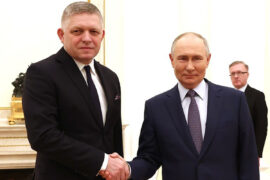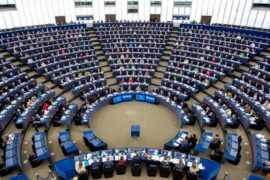
Brief look at the European economies
The EU and the US share the most important economic relationship in the world today. The EU and the US account for around one fifth of each other’s bilateral trade that amounts to about €1 billion a day. In 2003, exports of EU goods to the US amounted to € 226 billion (25.8 percent of total EU exports), while imports from the US amounted to € 157.2 billion (16.8 percent of total EU imports).
Moreover, the EU and the US are each other’s largest investment partner. The total amount of 2-way investment amounts to over € 1.5 trillion. Each partner employs directly and indirectly about 6 million people in the other. The share of EU investment in the US amounted to more than 52 percent of EU Foreign Direct Investment (FDI) over the period 1998-2001 (€ 162.663 million a year in average), while US investment in the EU amounted to more than 61 percent of EU FDI inflows over 1998-2001 (€72.041 million a year in average).
Despite occasional spats – caused almost exclusively by protectionism on both sides of the Atlantic – American decision-makers and commentators wish to see the EU prosper, for the current economic problems in the EU are harmful not just to the EU, but also to the US. As Americans see it, economic performance in Europe has been disappointing, with particularly pronounced weaknesses in Germany, Italy, and France. To quote Mickey Levy, Chief Economist at the Bank of America,
In the 1980s, average annualized economic growth in the EU15 was 2.5 percent, nearly 1 percentage point lower than in the United States, and in the 1990s… the gap widened: Europe’s 2.2 percent growth was 1.4 percentage points behind the United States. Since the European Monetary Union was established, eurozone growth has averaged 1.9 percent… while growth in the United States has averaged 2.6 percent.
Europe’s growth shortfall has been reflected in high unemployment rates. Between 1970 and 2003 the number of people employed in the United States rose by 58.9 million — a 75 percent increase. In France, Germany, and Italy combined, the figures were 17.6 million and 26 percent. Most of the new jobs were in the public sector. In addition to high unemployment levels, Europe faces unsustainable welfare commitments, especially with regard to its massive pay-as-you-go pensions systems. Unfunded liabilities arising from the pay-as-you-go public pension programs amount to more than 200 percent of GDP in France and Italy, and more than 150 percent of GDP in Germany. In fact, the EU Commission recently warned, “There is a risk of unsustainable public finances in some half of EU countries. Belgium, Germany, Greece, Spain, France, Italy, Austria and Portugal are on this black list.”
The lack of long-term sustainability of European welfare provisions is especially clear in the view of adverse demographics in key EU countries, such as Germany, France and Italy. Over the next 50 years Germany’s population will decline from 87 million to 67 million and Italy’s will decline from 58 million to 39 million. By the 2030s half of all Germans are expected to be over the age of 50 and half of Italians over the age of 54. By the 2030s every employee in the EU will support one retired person over the age of 65. Unless some reform is undertaken, Italy will have to increase its payroll taxes for pensions from 33 percent to 48 percent, an unrealistic percentage. The pension system in France is expected to be in deficit in eight years time. However, special interests have prevented thorough welfare reform from taking place throughout much of the EU.
Accessions of new members will exacerbate the above problems. Public budgets of West European countries, already stretched to the breaking point, cannot sustain the flow of capital, jobs and, consequently, taxes to the East. New members, however, encourage that eastward flow by pro-market policies, including low taxation and labor market deregulation. Western European welfare states are thus caught between “the rock and the hard place” of increasing public expenditures and increasing global and intra-European economic competition.
Costs and Benefits of the EU enlargement
The Czech and Slovak Republics, Poland, Hungary, Estonia, Latvia, Lithuania, Slovenia, Cyprus and Malta acceded to the EU in 2004. Many of the barriers to trade, investment, and movement of labor have disappeared. Exchange of knowledge, technology, and new ideas has become easier. Access to the common market improved the attractiveness of the CEECs as a destination for foreign investment and foreign competition will continue to improve business transparency and corporate accountability in CEE. Economies of scale will further reduce the prices and transaction costs. Productivity of capital and labor will also continue to increase. Consumer goods will continue to become cheaper, better in quality, and more diverse. Such are the advantages of joining the European common market.
However, full EU membership comes with considerable costs to optimal economic growth. For example, as a result of the enlargement negotiations, Estonia was forced to introduce 10,794 new tariffs against imports from outside of the EU. Estonia was also forced to adopt a number of nontariff barriers, such as quotas, subsidies, and anti-dumping duties. Unfortunately, such protectionism increases the prices of consumer goods and lowers the Estonians’ standard of living.
Membership of the EU has also subjected the new members to 97,000 pages of costly EU rules and regulations. The EU Commission expects that the EU environmental legislation alone will cost between 2 and 3 percent of new members’ annual GDP during the transition period of five to seven years. Though everyone prefers a clean environment, high environmental standards in the EU can only be met by increasing the tax burden of the already impoverished citizens of the accession countries. Some of the cost associated with the new members’ accession to the EU was supposed to be offset by financial aid from the West. But, between 2004 and 2006, the new members are set to net a total of 10.3 billion euros, or 3.4 billion euros per year. However, according to the EU Commission, the cost of environmental rules alone will reach 100 billion euros during the transitional period ending in 2013 or 11 billion euros per year. Clearly, the cost of the environmental chapter of the acqui communautaire necessitates greater government debt and higher taxes among new members.
Moreover, despite assurances to the contrary, the new members of the EU enjoy a decisively second-class status. In contradiction of the EU rules, workers from new members are prohibited from seeking employment in some Western countries. Moreover, farmers in the accession countries are subjected to unfair competition from Western farmers. Under the CAP, farmers in the West receive subsidies 4 times larger than those of their counterparts in the East.
The EU subsidies encourage overproduction. Therefore, a harmful system of production quotas has been put in place, leading to continuous bickering among the member states. Before accession, Slovakia, to give an example, asked to produce 1.2 billion litres of milk per year, but the EU agreed to only 950 million litres per year. Slovakia wished to raise 400,000 sheep, but the EU agreed to only 218,000 sheep. Farmers in the region can be excused for complaining that this type of economic planning is eerily reminiscent of Soviet-era production quotas.
Labor and safety standards
Over-regulation complicates the EU enlargement into the Central and Eastern European countries. Some blame the governing structure of the Union. The Brussels bureaucracy functions with minimal oversight by elected officials, turning out new regulations regardless of compliance costs. Over half of all regulations adopted by Europe’s national parliaments originate in Brussels. Even the former EU Commissioner for the Internal Market, Frits Bolkestein, has admitted that the EU has a “tendency to over regulate.” Regulations can sometimes correct market failure. But regulation also often creates failure and exacerbates economic problems. The proponents of regulation are often European states with extensive welfare provisions that want to hobble competition from their less-regulated European competitors.
Western European labor regulations, designed for wealthy societies, reduce the competitiveness of workers in the less-productive CEECs and may cause prolonged periods of high unemployment there (as they did in East Germany). The European Commission readily acknowledges the role it plays in fostering the economic problems in the CEE. The Commission’s Website says, “each new member must implement and enforce EU law, which includes key areas of social policy such as limits on working time, minimum standards of safety in the workplace, gender equality and other measures to combat discrimination. Thus the risk of ‘social dumping’ will be avoided.”
Far from combating a social ill, what the EU really does is engage in old-fashioned protectionism. As Vaclav Klaus, president of the Czech Republic, warned: “Social rights are disguised… attempts to protect high-cost producers in highly regulated countries, with unsustainable welfare standards, against cheaper labor in more productive countries.” Mirek Topolanek, Klaus’ successor as the head of the Civic Democratic Party (ODS), expressed his misgivings about the EU’s regulatory drive. According Topolanek, in order for the Czech economy to grow, the Czechs must have the necessary economic flexibility. “By adopting an array of incomprehensible [EU] laws and regulations . . . we have permanently foreclosed that option.”
Harmonization of production standards
The pan-European health and safety standards are a part of a much larger drive by the EU Commission to regulate production throughout the union. The euphemism, which is often used to describe harmonization of production standards, is “leveling of the playing field.” The concept of a “level playing field” implies equalization of production costs among different producers. That can be achieved in two ways. The first way is for the high-cost producers to cut their costs. Unfortunately, entrenched special interests make that very difficult to achieve. In the European countries, for example, government attempts to reduce social entitlements, such as unemployment benefits and bloated public pension schemes, meet with periodic strikes and mass demonstrations. Recent reforms of the German welfare system, for example, met with much resentment and the welfare cuts that the Bundestag eventually passed were so diluted that they have become economically insignificant.
The alternative approach is to increase the production costs of low-cost producers, thus rendering them less competitive. In Europe, harmonization increases the costs of production to levels favored by high-cost producers in Western Europe. That eliminates competition from low-cost producers, such as those in Central and Eastern Europe. This “capture” of international and supranational organizations by special interest groups determined to increase the cost of entry to businesses in poor countries is a growing problem. Safety standards of German food production are high, but wealthy German consumers can afford to pay higher food prices and that keeps German food producers in business. In Slovakia, on the other hand, 3,000 people in the dairy industry lost their jobs because their employers lacked the capital necessary to meet the EU standards of production.
Tax competition
Vigorous pursuit of harmonization of European rules and regulations by the bureaucracy in Brussels restrains European nations from offering businesses better conditions than their neighbors can. That leaves tax rates, which continue to be determined at a national level, as the primary policy tool to affect the competitiveness of European companies. The CEECs have been most aggressive in pursuing this particular developmental strategy. For example, Estonia has a zero percent corporate tax on reinvested or retained profits. Latvia and Lithuania have corporate tax rates of 15 percent; Hungary 16; Poland and Slovakia 19. Of course, the EU accession countries use lower tax rates to compensate for the lower productivity of their workers and their high level of government corruption. But the tax rates in CEE are sufficiently low to get the attention of the current EU members. For example, as a result of tax reduction in neighboring Slovakia, Austria’s top corporate tax rate was lowered from 34 to 25 percent.
Some current EU members see tax cutting as a threat. The German Chancellor Gerhard Schroeder and his finance minister Hans Eichel tried to intimidate the new members into reversing their business-friendly economic policies. The German politicians may well be the least qualified to call for such measures. They are the ones who preside over one of the most botched-up attempts at economic development in the post-communist era. By increasing the cost of doing business in the former East Germany, the German politicians consigned large number of East Germans to seemingly perpetual unemployment. Today East Germany continues to be a huge sinkhole that has already swallowed well over DM 2 trillion in wealth transfers from West Germany. Should the new members succumb to German pressure, switch course and adopt the policies currently practiced by the welfare states of Western Europe, the consequences for the new members would be devastating.
The conflict at the heart of EU enlargement could not be starker. On the one hand, many current EU members are determined to pursue a policy of job protection and high taxation, necessitated by growing welfare costs. On the other hand, the new EU members, whose citizens continue living in relative poverty, need to generate rapid economic growth and catch up with the West.
The future of the EU: an ever-freer Union?
Centralization of decision-making and harmonization of the regulatory burden distribute the costs and benefits between the member states unequally. Such implicit wealth transfers may work relatively well in homogenous societies, but they create serious problems in heterogeneous societies. In order to work, wealth transfers require a cohesive “demos” with a highly evolved sense of common identity. The more people identify with a particular group, the more willing they are to make sacrifices; witness the family. But Europe has no such common identity. According to a 1999 poll by the EU Commission, on average, only 4 percent of the people in the pre-enlargement EU felt first and foremost “European.” In fact, public opinion surveys, election and referenda results in Europe demonstrate that centralization and harmonization breed resentment, create negative-sum outcomes, and intensify political struggles. If centralization of political decision-making persists, the EU will weaken and may fall apart.
Alternatively, Europe could opt for a decentralized model – more akin to the North Atlantic Free Trade Agreement (NAFTA). In the past, Harvard University historian David Landes writes, “Fragmentation gave rise to competition and competition favored good care of good subjects. . . . European rulers and enterprising lords who sought to grow revenues . . . had to attract participants by the grants of franchises, freedoms and privileges—in short, by making deals. They had to persuade them to come.” To put it differently, the lack of political and economic uniformity enabled Europe to thrive in the past. Decentralized political entities such as the United States still provide laboratories of social policy. Like American states today, autonomous city-states in Europe in the past offered an assortment of freedoms to potential immigrants. Many immigrants brought knowledge and expertise that improved the societies they joined. The future of the European project, in my view, lies in a “voluntarist” Europe, where individual states, businesses and persons will be free to choose the nature and the extent of their cooperation.
Autor je zástupca riaditeľa Projektu svetovej ekonomickej slobody v rámci CATO Institute, Washington, D. C.
Prednáška odznela na konferencii The Economic and Political Context of Central Europe – European Union Relations, ktorú organizoval Bratislavský inštitút medzinárodných vzťahov pri Vysokej škole manažmentu – City University Bratislava a Konzervatívny inštitút M. R. Štefánika dňa 14. júna 2005 v Bratislave.
Prednášku vo formáte PDF si môžete stiahnuť tu.






